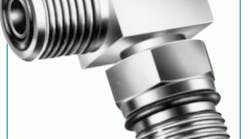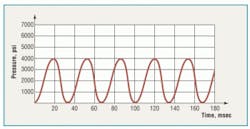Users of hydraulic systems are demanding cost effective, leak-proof and reliable components with high power density. This means higher working pressures, increased simplification of piping systems, and fewer potential leak points. A limitation for increasing the pressure capacity of existing threaded port systems is that the seal diameter is the thread undercut diameter. To accommodate higher-pressures, the fitting body cross section area must be increased. But this would also increases the seal diameter and pressure acting area, resulting in a higher load force and no gain in pressure holding capacity.
In the new SAE J2337 port and fitting system, sealing occurs in the bottom of the port, which, on average, doubles pressure capacity. Moreover, the swivel nut feature eliminates the need for adapter fittings and, therefore, can cut the number of potential leak points in half. Test results support working pressures up to 80,000 with a design factor of 4:1.
Demands from industry
A priority for the 21st century among users of hydraulic systems is to maintain or reduce component cost. The best way to reduce cost is to increase component power density - that is, the ratio of power output to the weight or volume of the component. The only way to increase or maintain the power output with a simultaneous decrease of volume and component weight is to increase the systHigher performance - In some industries, such as aerospace, the size and efficiency of components - not only cost - are critical factors. The continuing trend is for lighter components with higher performance - known as miniaturization. Miniaturization of parts can be accomplished only if the system pressure is increased. To meet requirements of the aerospace industry, system pressures of up to 8000 psi are not uncommon.
Leak-free systems - A potential problem that can accompany higher operating pressure is leakage. Forty years ago, hydraulic systems typically operated at 300 psi. Today, 3000-psi systems are common, and some are rated at 5000 or even 6000 psi.
Another potential problem that can accompany high-pressure systems is pressure spikes and high cycling of dynamic loads that can cause unpredictable peak pressures. Consequently, fittings and hoses are subjected to high stress. Therefore, to prevent leakage, fittings must contain fluid at these higher pressures.
Current limitations
Swelling, deformation, internal stresses, and cracking of the component body may result because of the conical nature and the extremely high radial forces created when tightening the fitting body into the port. Furthermore, in some valve and pump designs, even low stresses can deform adjacent passageways, such as the bore for valve spools and closely machined ports. To compensate for this limitation, components must have a large bulky design, which results in excess weight and higher costs.
Orientation problems with the tapered thread joint have always been a big disadvantage. Aprroximately two turns are needed after hand tight engagement to get proper sealing. But at the same time, the fitting often is oriented in the wrong direction. Assemblers often encounter installation problems that result in an unreliable joint and increased high costs.
O-Ring boss port fittings - Straight thread O-ring boss port fittings, Figure 2 (SAE 2244, ISO 6149, DIN 3852, JIS B 2351) were developed in the early 1950s and are a good solution for many hydraulic systems. However, considering today's higher system pressures, it is at its upper performance limit based on its design.
The pressure rating for a straight connector is 6000 psi for smaller sizes and 4000 psi for larger sizes. For adjustable fittings, the pressure rating is 6000 psi for smaller sizes and 3000 psi for larger sizes. SAE J2244 is rated to 9100 psi.
Furthermore, the potential for any improvements is limited. Assuming that the use of stronger heat-treated material is unacceptable because of cost, and that flow capacity cannot be reduced, the following explanation shows the limitations:
If a stronger fitting is needed, stress from fluid pressure must be reduced. To lower the stress, we must increase area by an increasing the outer diameter. To avoid changing flow capacity, the inner diameter must remain the same. But a substantial increase in fitting body size produces only a slight increase in performance. for example, increasing the OD of the fitting by 10% reduces stress by only 8.3%. Likewise, increasing the OD by 20% or 30% reduces stress by only 14.0% or 19.5%, respectively.
The problem is the pressure load and stress pattern of O-ring boss port fittings. It creates axial load, which tends to pull the connector out from the port; and radial load, which tends to open the female port from pressure acting all the way up to the O-ring itself. The stress pattern of the port is the reason that - even with moderate fluid pressures - requires significant material wall thickness to withstand intensive radial port deformation.
This characteristic especially affects aluminum, cast iron, and weaker materials. Even with a significant increase of wall thickness, fatigue working conditions eventually will produce cracks and failures as a direct consequence of stress distribution. Experimental fatigue testing shows that failure of aluminum housings occurs at a relatively low number of cycles with a 4000-psi peak cycle load applied at only 28 Hz.
Other straight-thread port fittings - Performance data for the straight thread port with retaining ring, metal elastomer bonded seal, cutting face, or soft metal seal, figure 3, are similar to those of the O-ring boss port SAE J1926, as just explained. Maximum pressure rating is 5800 psi.
Future requirements - Based on international demands of the fluid power industry, fittings for the 21st century must :
* be leak proof at pressures higher than 9000 psi and with a minimum design factor of 4:1,
* reduce the number of potential leak points,
* be cost effective,
* be easy to install,
* have a design that will not impose limits on future performance requirements,
* be lightweight,
* have metric threads,
* be non-interchangeable with existing port styles,
* be able to accommodate difficult assembly challenges,
* not require brazed or welded joints,
* be readily reusable,
* be able to tolerate overtorquing,
* accommodate high flow capacity, and
* not exhibit sudden flow passage cross sectional changes, thereby reducing turbulence, heating, and energy loss.
Characteristics of the fitting
The SAE J2337 port-and-fitting system, Figure 4, is a new concept in fitting design. Design characteristics inherent to its success are:
* a significant reduction of the acting force on the port system due to fluid pressure,
* lighter weight, yet higher strength,
* flow capacities consistent with existing port systems, and
* leak-free performance.
Reducing the pressure-acting area can reduce the acting force from fluid pressure. This means that the O-ring must have as small a diameter as possible, but larger than that of the flow passage. This is accomplished by placing the O-ring in the bottom of the port. The table below shows how pressure capacity performance was increased compared to the O-ring boss system for the same size.
This improvement is significant because all forces acting on the fitting due to pressure are reduced an average of 100.5%. Consequently, the lower stresses that result enable reduction of the cross-section areas and the amount of material used in the fitting and the port. Furthermore, lighter and weaker metals, such as aluminum or cast iron, can be used at higher pressures than before. The result is a lighter product manufactured at reduced cost and with improved performance.
The double seal characteristic greatly improves resistance to leakage. It consists of a conical metal-to-metal seal and a radial O-ring seal. The main advantage of this configuration is the extrusion resistance of the O-ring, which is attributed to zero clearance in the critical corner of the O-ring groove. This is achieved by the firm, even, cold-forged surface contact on the conical surface that occurs when tightening the fitting.
The swivel feature eliminates the need for an adapter and eliminates one potential leak point in a typical tube and/or hose connection to the component body. Figure 6 compares both installations with the same functional features.
This comparison can be extended to any other tube connection such as 24° cone compression, 37° flare, and many others. In addition to cost reduction and simplification, the swivel feature reduces installation time, reduces assembly problems, and simplifies plumbing systems.
Results from cycle testing
Six samples of size 6, 8, and 16 were cycle-tested for 1 million cycles to peak pressure. All samples were in excellent condition after cycling and were 100% usable without damage.
Two SAE J2337 fittings, size 8 and 6, were fatigue-tested and assembled in a hydraulic pump housing made of aluminum. The cycle pattern is shown in Figure 7, below. Higher vibration conditions were also applied during testing.
O-Ring boss ports tested in the aluminum housing did not produce satisfactory results. Cracks and separations occurred at various times up to an average of 400,000 cycles. The SAE J2337 port and fitting, on the other hand, performed without any failure to 26 million cycles. These results reinforce the advantage of the stress pattern of the port and the optimum stress pattern of the SAE J2337 fitting.
Benefits realized
As anticipated, the J2337 fitting provides a number of benefits to both OEMs and users:
* higher pressure capabilities,
* zero leakage,
* elimination of adapter and one potential leak point in a typical hydraulic assembly,
* one-piece construction of adapters, so no brazed or welded joints are needed,
* no-swing assembly,
* no accidental O-ring drop out,
* simple port geometry,
* unlimited reusability,
* minimal influence on the adjacent port structure, and
* minimal chance of becoming over-torqued during assembly.
Summary
Equipment manufacturers and users of hydraulic systems are demanding lighter, more powerful components. Components must be built with a higher degree of power density, which necessitates higher system pressures. Current hydraulic components typically can operate at up to 6000 psi working pressure, limited, to a high degree, by existing port and fitting systems.
The main disadvantage of existing threaded port/fitting systems is the placement of the O-ring on the undercut diameter. Potential for improvement of these designs is limited. Increasing the thread size would result in a stronger cross section, but create a higher load force and increase the pressure acting area.
The new SAE J2337 port and fitting system does not suffer this limitation because sealing occurs in the bottom of the port. Pressure capacity is increased an average of 100%. This innovative design allows for higher-pressure ratings for future requirements.
The swivel feature eliminates the need for adapter fittings when elbow positioning is required. Test results support working pressures up to 12,000 psi with a design factor of 4:1.
The double seal principle ensures much higher leak proof performance. Substantial savings result when replacing 4-bolt flange systems.
Darko Brozovic was product engineering manager at Fluid Line Products Inc., Willoughby, Ohio when this article was originally published. The SAE J2337 fitting design is based on his patent, which was originally developed for Fluid Line Products' Uniport 10K fitting. For more information, click here to visit the website or email [email protected].









